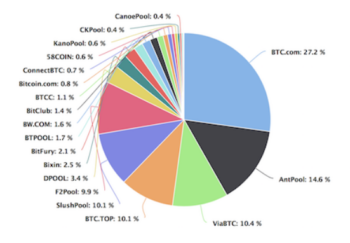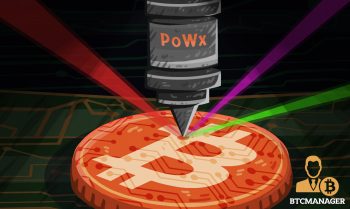
With bitcoin becoming more competitive, a new organization looks to bring decentralization back to mining by renovating the Proof of Work (PoW) consensus algorithm that some miners have come to love. The premise, in short, hopes to replace energy costs with manufacturing costs.
Miner Profitability and Environmental Concerns
PoWx is the foundation behind a new algorithm called OPoW, or Optical Proof of Work. The group, backed by CobraBitcoin and Bitcoin developer Luke Dash Jr., looks to develop open source hardware capable of running a revised algorithm based on optical computing to bring massive power savings and lower the barrier of entry for mining.
Optical computing is being adopted across many other fields of computation as it offers higher bandwidth via the use of photons rather than electrons. The PoW revision in question proposes the use of APSICs or Application Specific Photonic Integrated Circuits.
Great interview with @MikeDubrovsky on PoWx by @BitcoinErrorLog: https://t.co/ToFUKsERNb
— Shinobi, CEO of Bitcoin (@brian_trollz) July 8, 2018
PoWx may potentially replace the costs of energy with hardware depreciation, which provides many benefits for miners.
Specifically, this opens the possibility for miners to set up shop in other locations where electricity isn’t necessarily at rock bottom prices. The highly competitive mining market, along with Bitcoin’s staggering power requirements, have turned a handful of locations into hubs for the activity. Miners have already begun flocking to places with ideal conditions like cold weather, friendly regulations, and a relatively low cost of energy.
With OPoW being more energy efficient than PoW, miners would have a bit more flexibility in location and get away with more generalized hardware before requiring specialized equipment like ASICs.
This feature also helps the cryptocurrency network on the whole as draconian regulations on power usage will be less of a factor. Dependency on low electricity costs inadvertently means depending on governments controlling these costs. Primary examples include both Russia and China’s crackdown on miners in the respective countries.
With electricity being less of a concern as well, the network is immediately more independent of government power plants, allowing users to power their hardware through off-grid solar arrays or other energy sources.
Statistically, the Bitcoin network needs the same levels of electricity usage as a handful of developed nations, and besides maintaining the network, it serves no other benefit. Naturally, this has caused great alarm to environmentalists, but, according to critics, it must be compared to the electricity costs of payment platforms like Visa and MasterCard as well as the cost of mining precious metals like gold and silver.
https://twitter.com/nic__carter/status/933701574026809344
Regardless of the side one takes regarding the current consensus algorithm, OPoW does present an alternative to potentially minimize Bitcoin’s carbon footprint. As of now, there is no defined roadmap or exact figures of the potential energy savings. Estimations for a release in early 2019 have been given, but for now, PoWx remains merely a provocative idea.
Bitmain’s Centralized Stranglehold
The mining firm’s massive network of miners has turned many away from Bitcoin’s network and on to other alternative projects. Fears of collusion and centralization place the owner of the enterprise in the same field as oil tycoons and other monopolies cryptocurrencies hope to topple.
At current, Jihan Wu’s company owns nearly 50 percent of the network’s mining power. Wu has, however, confirmed that holding the majority of the network is not in the best interests of Bitmain. It is difficult to determine if this confirmation is derived from a business perspective or an admission to the current decline in their power over SHA-256 mining.

Bitmain owns both Antpool and BTC.com mining pools
(Source: TRUSTNODES)
OPoW would also lower the barrier of entry for mining as the hardware would be based on older 200nm fabrication, compared to modern ASICs at 7nm. As the previous manufacturing process is more established and cheaper, this, in turn, means hardware will be cheaper as well.
With Bitmain currently dominating the mining sector in terms of manufacturing and mining, it puts the entire Bitcoin network at risk if their intentions were to turn for the worse. ASICs have continually shrunk to chase higher energy efficiency (more hashes per watt), but newer manufacturing processes require massive amounts of R&D.
Using a 200nm process would mean hardware manufacturers would need little capital to start developing new hardware and would allow average users to purchase mining hardware for themselves.
Criticism and end Points
The immediate question that arises is that of merely implementing a hardfork and implementing this alternative consensus algorithm this way. While the answer to this is speculative, some have accused both CobraBitcoin and Luke Dash Jr. of overstating the threat of Bitmain on the network. This is based on the theory that Bitmain may not necessarily be able to achieve a majority hold on the network or that Cobra and Luke may have adverse intentions.

Bitcoin’s hashrate since the Bitcoin Cash (BCH) hardfork
(Source: Bitinfocharts)
Second, and from a technical standpoint, an adjustment to the network at this point would undermine the culmination effects of bitcoin’s hashrate. Such an amendment thus features as a weakening in security. For the uninitiated, a networks hashrate helps to quantify the difficulty in mining a specific cryptocurrency as well as the number of active miners. A lower hashrate is thus easier to compromise and more susceptible to threats like centralization.
The promise of OPoW has sparked interest among many. The threat that Bitcoin, and mining in general, purport for the environment is perhaps that greatest attractor. Novel consensus algorithms such as PoS, DPoS, and others hope to reduce this threat along with the economic incentives tucked into Bitcoin’s current algorithm. The latter point, that of concerns surrounding Bitmain, is also a draw if only to reveal a greater fear in the cryptocurrency sector, that of centralization.
The following article was co-authored by BTCManager’s Chief Editor Liam J. Kelly.
The post PoWx’s Optical Proof of Work May Solve two of Bitcoin’s Biggest Problems appeared first on BTCMANAGER.
Author: BTCManager.com

Leave a Reply